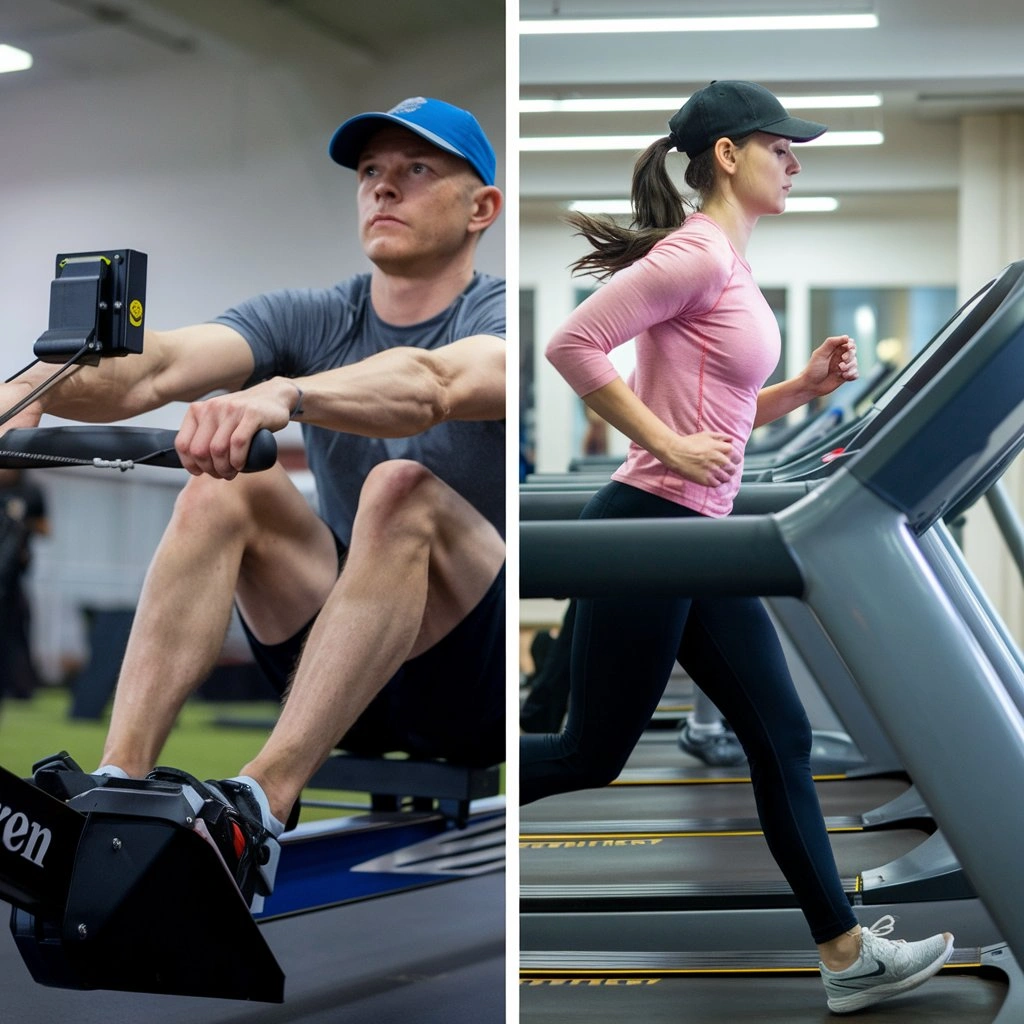When it comes to staying fit and healthy, there’s a plethora of exercise options to choose from. Two popular choices are rowing and treadmill workouts. They often find themselves in the spotlight. Both of these exercises offer unique benefits. They accommodate various tastes and health objectives. Let’s look at them closely. We’ll understand their importance for a healthy life.
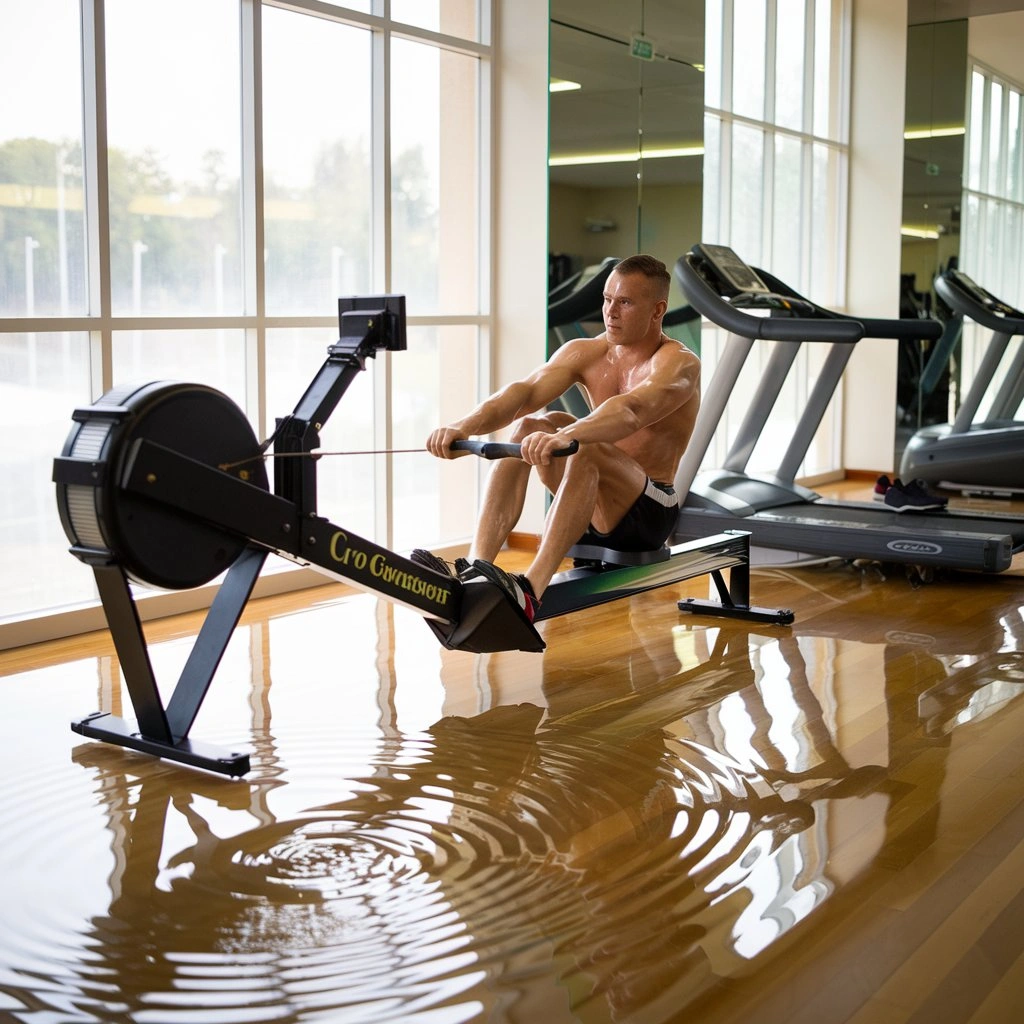
A brief Overview of Rowing and Treadmill Exercises
Rowing is a full-body workout that mimics the motion of rowing a boat. You use a rowing machine. It has a sliding seat, handles, and a resistance mechanism. As you pull the handles towards your chest, you use muscles in your arms, shoulders, back, and legs. This provides a full workout for your heart and strength.
Treadmill exercise involves walking, jogging, or running on a stationary machine. The machine has a moving belt. It allows individuals to control their speed and incline. They can use it to simulate various terrains and levels of outdoor walking or running. Treadmills are an effective way to improve heart health. They burn calories and build endurance.
Importance of Cardiovascular Exercise in Fitness Routines
Rowing vs Treadmill workouts are types of cardiovascular exercise. They are crucial for maintaining health and fitness. These activities raise heart rate and boost blood flow. This strengthens the heart muscle and makes it more efficient. Regular exercise helps lower blood pressure. It also reduces the risk of heart disease and improves cholesterol.
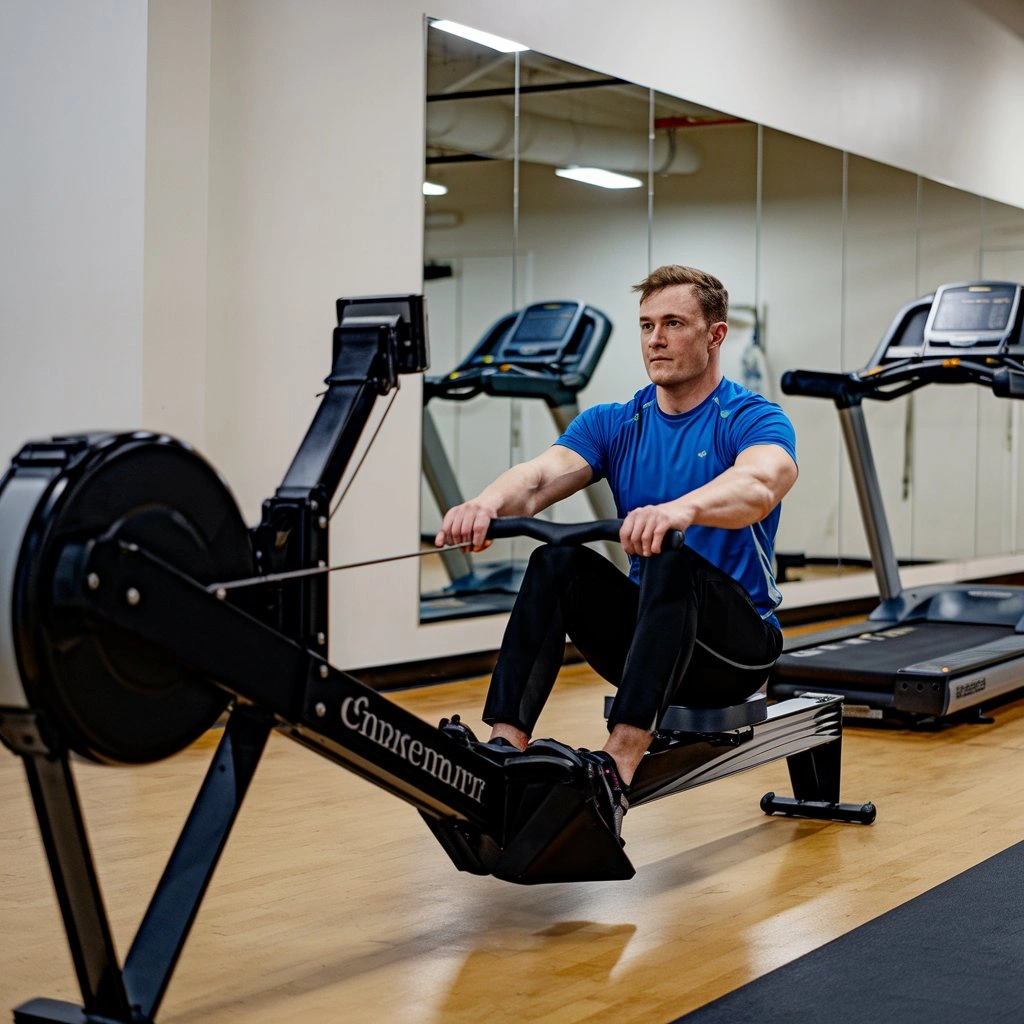
Also, adding cardio to your fitness routine can help manage weight. It burns calories and promotes fat loss. It boosts metabolism. It helps the body use oxygen better. This increases one’s vitality and endurance.
Rowing
Rowing is a fantastic exercise that works out your whole body while you glide on water or use a rowing machine. It’s like a dance between you and the water or the machine. You sit on a sliding seat, holding onto a handle, and push and pull it in a smooth, rhythmic motion.
Description of Rowing Exercise
How to Get Started
- Learn the basics: If you’re rowing on the water, it’s essential to learn the basics of rowing technique. Start with a beginner’s class or enlist the help of a coach.
- Safety first: When rowing, always wear a life jacket. Also, make sure you know the water where you’ll be rowing.
- Start slow: Take it gradually at the start; don’t exert too much effort. Then, as you get more comfortable, slowly raise the intensity.
- Mix it up: Rowing can be as relaxing or as intense as you want it to be. Try different types of rowing workouts. These include steady-state rowing, interval training, and rowing races.
- Stay consistent: Like any exercise, consistency is key. Aim to row at least a few times a week to see the best results.
Benefits of Rowing
- Cardiovascular Benefits: Rowing has cardiovascular benefits. It increases cardiac health and gets your heart beating. Rowing engages large muscles in your legs, arms, and back. This increases your heart rate and helps strengthen your heart over time. Rowing regularly can boost your endurance and stamina. It makes daily tasks feel easier and reduces the risk of heart issues.
- Full-Body Workout: Rowing has a standout advantage. It gives a full-body workout. Rowing is different from some other forms of exercise. They focus on specific muscle groups. Rowing engages many muscle groups at once. As you push through the rowing motion, you work your legs, core, back, arms, and shoulders. This approach means you can tone and strengthen your whole body with just one exercise. Rowing is efficient. It’s a good choice for those looking to improve fitness and muscle tone.
- Low Impact on Joints: Running and jumping stress your joints. Rowing is different. It is a low-impact exercise. Rowing has a smooth, fluid motion. It puts less stress on your knees, hips, and ankles. So, it’s an excellent option for people with joint issues or recovering from injuries. Rowing is low-impact. This means it is suitable for people of all ages and fitness levels. They can reap the benefits of exercise without risking injury or discomfort.
- Calorie burning: Rowing is like a calorie-burning machine! When you row, you’re using lots of energy, which helps you burn calories. It’s like going on a fun adventure where you get to burn off all those extra calories from your favorite snacks. So, if you want to keep your body healthy and strong, rowing is a great way to do it!
- Relieving stress: Rowing is similar to taking a mental vacation! When you row, you get to focus on the rhythm of your movements and the feeling of gliding through the water. It’s like taking a break from all the worries and stress of everyday life. Rowing can help you feel calm and relaxed like you’re floating on a peaceful lake. So, if you need a break from the hustle, hop on a rowing machine. Or, take a rowboat out for a spin. Your mind will thank you!
Technique and form in Rowing
Sure thing! In rowing, good technique is vital. It helps you get the most from your workout and avoid strain or injury. Here’s a breakdown of the basics without using any tricky words:
- The Catch: This is where you start your rowing stroke. With your feet tucked into the foot straps and your knees bent, take a seat on the rowing machine. Lean slightly forward from your hips. Stretch your arms out in front of you and hold onto the handlebar.
- The Drive: This is the powerful part of the stroke where you push with your legs. Start by pushing with your legs while keeping your arms straight. Lean back a little until your legs are nearly completely stretched. Pull the handlebar towards your chest using your arms and back. Imagine you’re pushing away from a wall with your legs. Then, you pull yourself past that wall with your arms.
- The Finish: This is where you complete the rowing stroke. Your legs should be fully extended. Your torso should lean back slightly. The handlebar should be pulled towards your chest just below your ribs. Assume a flat wrist position and keep your elbows near your body. This position is like reaching the end of a big stretch – you’re long and tall!
- The Recovery: After the big drive, it’s time to return smoothly to the start. Start by straightening your arms, and letting the handlebar move away from your chest. Then, smoothly bend your knees and lean forward from your hips to return to the catch position. This part is like taking a deep breath and getting ready to start again.
- Breathing: Don’t forget to breathe! Inhale as you return to the catch position, and exhale as you drive back. Keeping your breathing steady helps you stay focused. It gives you energy during your rowing session.
- Smooth and Controlled Movements: Rowing is all about smooth, fluid movements. Avoid jerky motions or rushing through the strokes. Focus on maintaining a steady rhythm and controlled pace throughout your workout.
Common Mistakes to Avoid
Certainly! Rowing is a great sport. It gives a full-body workout. And, you can enjoy the calm of being on the water. However, like any sport, there are common mistakes beginners often make. Let’s go through some of them

- Incorrect Posture: One of the most common mistakes in rowing is having poor posture. It’s important to sit up straight with your back tall and your shoulders relaxed. Slouching not only affects your performance but can also lead to back pain.
- Holding the oar too tightly creates arm and shoulder tension: This makes rowing harder. Instead, aim for a relaxed grip, holding the oar firmly but not squeezing too hard.
- Ignoring Technique: Rowing is all about technique. Beginners often just focus on pulling the oar. They ignore the order of movements or their body’s position. Take the time to learn proper rowing techniques from a qualified instructor. This will maximize your efficiency and prevent injury.
- Rushing the Recovery: The recovery phase of the rowing stroke is just as important as the drive phase. Beginners often rush through the recovery. This can throw off their rhythm and decrease their power. Focus on keeping a smooth recovery. This will set you up for a powerful drive.
- Overreaching: Reaching too far forward with your car causes you to lose balance. It also disrupts your stroke. Instead, try to keep your movements fluid and controlled. Reach just enough to catch the water without overextending.
- Ignoring Your Core: Rowing works the whole body. Your core is key. It keeps your body stable during the stroke. Neglecting your core strength can lead to poor technique and decreased performance. Keep your core muscles engaged. Do this during the rowing motion. It will keep you stable and powerful.
- Not Paying Attention to Breathing: Proper breathing technique is often overlooked in rowing. Remember to breathe steadily and rhythmically. Inhale as you drive and exhale as you recover. This helps to oxygenate your muscles and maintain a consistent pace.
- Skipping the warm-up and cool-down is risky: Rowing, like any physical activity, requires them. They prevent injury and aid recovery. Skipping these important steps can increase your risk of muscle strain and stiffness. Take time to warm up your muscles with dynamic stretches before rowing. Cool down with gentle stretches afterward.
Types of Rowing Machines
- Air Resistance Rowing Machines: These rowing machines use a flywheel with fan blades. They use them to create resistance. As you pull the handle, the fan spins and creates resistance by moving air. You will experience increased resistance the harder you pull. These machines are known for their smooth and dynamic resistance. They simulate the feel of rowing on water.
- Magnetic Resistance Rowing Machines: These rowing machines use magnets. They do not use air to create resistance. They have a magnetic braking system that adjusts the resistance level. You can usually adjust the resistance manually with a knob. Or, do it digitally through the machine’s settings. Magnetic rowers tend to operate quietly and offer a consistent resistance level.
- Water Resistance Rowing Machines: These rowing machines have a water-filled flywheel tank. It provides resistance as you row. As you pull the handle, you’re moving paddles through the water. This creates resistance. Water from the tank may be added to or removed to change the resistance level. Water rowers offer real rowing. They have the sound and feel of rowing on water.
- Hydraulic Piston Rowing Machines: These rowing machines use hydraulic pistons to create resistance. The pistons are attached to the handles. As you pull, they compress hydraulic fluid to create resistance. You can usually adjust the resistance level by changing the tension on the pistons. Home use is appropriate for hydraulic rowers as they are often lightweight and small.
- Combination Rowing Machines: Some rowing machines combine different resistance mechanisms. For example, a rower might use both air and magnetic resistance. You can choose between them or even combine them for a custom workout. Combination rowers aim to provide a versatile workout. They cater to different preferences and fitness levels.
Treadmill
Description of Treadmill Exercise
Treadmill exercise is like walking or running. But, it’s indoors on a special machine called a treadmill. It’s a popular way to get some good exercise, whether it’s too hot, too cold, or even raining outside. Picture it like this: you stand on a moving surface, like a wide conveyor belt. You can adjust it to go faster or slower, depending on how fast you want to walk or run.
The treadmill usually has handles you can hold onto for balance or support if you need it. Some treadmills even have fancy screens. On them, you can watch TV or track your progress. You can see how far you’ve walked or run, how many calories you’ve burned, and sometimes even your heart rate.
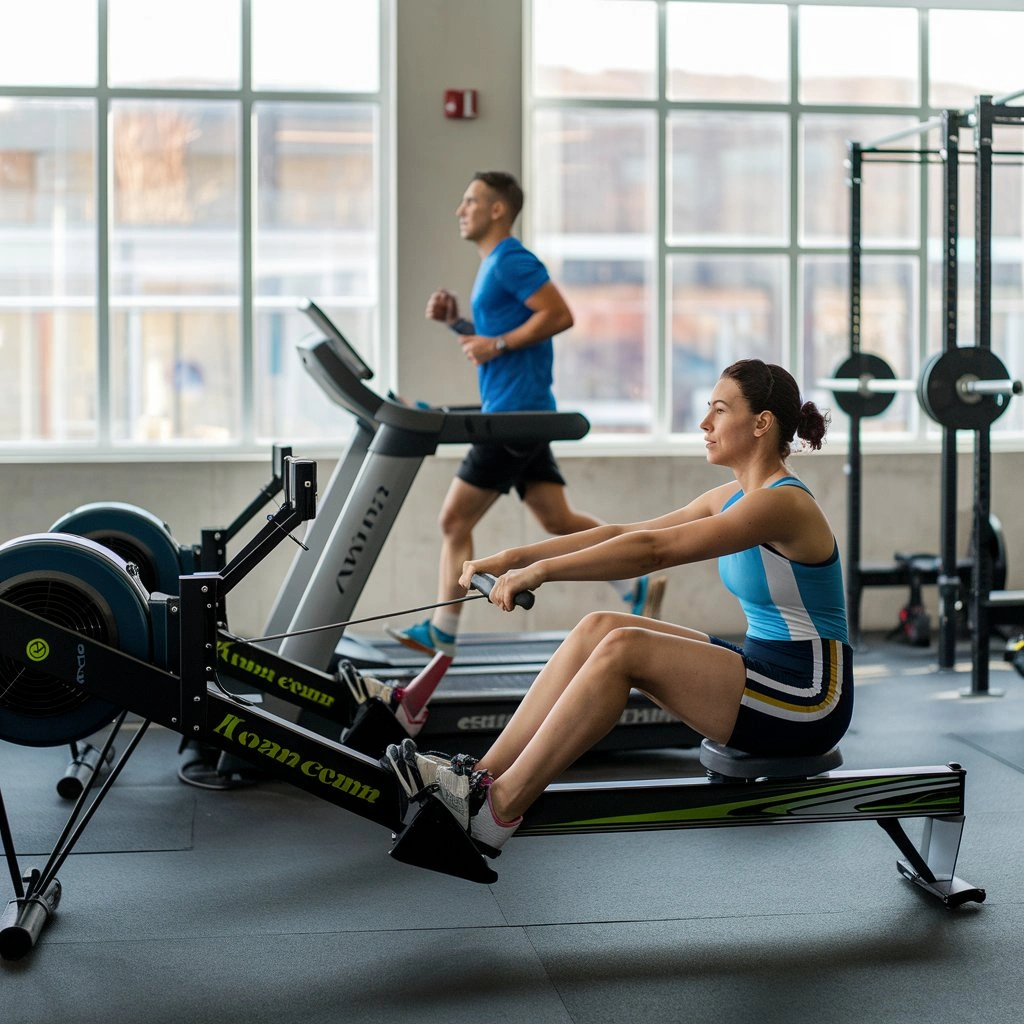
When you start walking or running on a treadmill, it’s like going for a stroll or a jog, but you never leave the same spot. You control the speed with buttons or knobs. You have the option to make it harder or easy. You can increase the speed for more challenges. You can also raise the incline. It makes it feel like you’re walking or running uphill.
Treadmill exercise is cool. You can control how hard and how long you work out. If you’re just starting or taking it easy, you can go slow and steady. But if you’re up for a challenge, you can push yourself to go faster. Or, you can try interval training. In it, you alternate between fast and slow speeds.
Benefits of Treadmill Running
- Convenience: One of the best things about treadmill running is that you can do it indoors, rain or shine. You don’t have to worry about the weather conditions or finding a safe place to run outside. Also, you can use the treadmill anytime. You are not required to go anywhere in particular.
- Controlled Environment: With a treadmill, you have full control over the running surface. The inclination and pace may be changed to meet your objectives and level of fitness. This lets you slowly raise the intensity of your workout. You do this as you get stronger and fitter.
- Safety: Treadmills are safe for running. They are good for those worried about outdoor running due to traffic or rough ground. You don’t have to worry about tripping over obstacles or getting injured from a fall.
- Customizable Workouts: Most treadmills have built-in workout programs. They let you customize your workouts based on your preferences. You can focus on endurance, speed, or incline training. You can easily adjust the settings to tailor your workout to your needs.
- Joint-Friendly: Running on a treadmill is easier on your joints. This is compared to running on hard pavement. The treadmill has a cushioned surface. It absorbs some of the impact. This reduces the risk of injuries to your knees, ankles, and hips.
- Monitoring Progress: Many treadmills have heart rate monitors. They also have distance and calorie counters. They let you track your progress and fitness goals over time. This can be a great motivator to help you stay on track and see improvements in your performance.
- Versatility: In addition to running, treadmills can also be used for walking. They are also good for jogging or interval training. This versatility makes them good for people of all fitness levels. It’s for beginners to advanced athletes.
- Accessibility: Treadmills are easy to find. They are in gyms, fitness centers, and even some homes. This makes it easy to add treadmill running to your regular exercise routine. It functions wherever you go.
Proper Running form on a Treadmill
Good form is key for treadmill running. It helps you avoid injury and stay comfy during your workout. Here’s a breakdown of proper running form on a treadmill:
- Posture: Stand tall and relaxed. Keep your head up and look straight ahead, not down at your feet or the console. Keep your shoulders relaxed and back, and avoid slouching forward.
- Foot Placement: Place your feet directly under your hips as you run. Don’t overstride (taking too long of steps), as it can strain your muscles and joints. Instead, aim for a natural stride length. Your foot should land comfortably beneath you.
- Foot Strike: Avoid landing on your heel by aiming for a midfoot or forefoot strike. This lessens the chance of harm and absorbs shock. Imagine landing softly, almost like you’re sneaking up on someone.
- Arm Position: Keep your arms bent at 90 degrees. Not across your body, but back and forth. Your hands should lightly brush your hips as they swing. This avoids tension in your shoulders and arms.
- Core Engagement: Engage your core muscles. Do this by gently pulling your belly button toward your spine. This helps stabilize your body and maintain balance as you run.
- Breathing: Breathe naturally and rhythmically, in sync with your steps. Avoid holding your breath or taking shallow breaths, as it can lead to fatigue more quickly.
- Pace and Speed: Start at a comfortable pace and gradually increase your speed as you warm up. Pay attention to your body’s cues and modify the pace accordingly. Avoid starting too fast or pushing too hard. This is especially true if you’re new to running or haven’t warmed up.
- Grip: Lightly hold onto the handrails or sidebars for balance, but try not to rely on them too much. Using the handrails too much can hurt your posture and stride. Poor running form may result from this.
- Cooldown and Stretch: After your run, take some time to cool down by walking or jogging at a slower pace. Then, stretch your muscles gently to prevent stiffness and aid in recovery.
Safety Precautions When Using a Treadmill
Using a treadmill is a great way to get your heart pumping and stay fit. But, you must take safety steps to avoid accidents or injuries. Here are some simple tips to keep you safe while using a treadmill
- Start slow: When you first get on the treadmill, go at a slow pace. This will warm up your muscles and help you get used to the movement. You can gradually increase the speed as you feel more comfortable.
- Wear Proper Shoes: Make sure to wear athletic shoes with good traction when using a treadmill. This will help prevent slipping and provide support for your feet.
- Use the Safety Clip: Most treadmills come with a safety clip that attaches to your clothing. If you slip or fall, the clip will stop the treadmill. This will prevent further accidents. Always remember to attach the safety clip before starting your workout.
- Stay Hydrated: Keep a water bottle nearby. To keep hydrated during your workout, take a little sip of water. It’s important to replace fluids lost through sweating to prevent dehydration.
- Pay attention: Stay focused on your workout. Avoid distractions like texting or TV. Keep your eyes on the treadmill and be aware of your surroundings.
- Use Handrails Sparingly: It might be tempting to hold them for support. But, try to use them sparingly. Holding the handrails too tightly can hurt your posture and balance. Injury or strain may result from it.
- Position yourself correctly: Stand in the middle of the treadmill with your feet shoulder-width apart. Avoid stooping too far forward or backward and maintain an upright posture.
- Listen to Your Body: If you feel dizzy or lightheaded, or have any pain while using the treadmill, stop right away. Take a break. It’s vital to be aware of your body and refrain from overdoing it.
- Cool Down: After your workout, slow down the treadmill to cool your muscles. Later on, this will assist avoid discomfort and stiffness.
- Clean the treadmill: Sweat can build up on it. This makes it slippery and unhygienic. After each use, wipe down the treadmill with a clean towel to remove any sweat or debris.
Different Types of Treadmills are Available
Treadmills come in all shapes and sizes. They are designed to suit various needs and preferences. 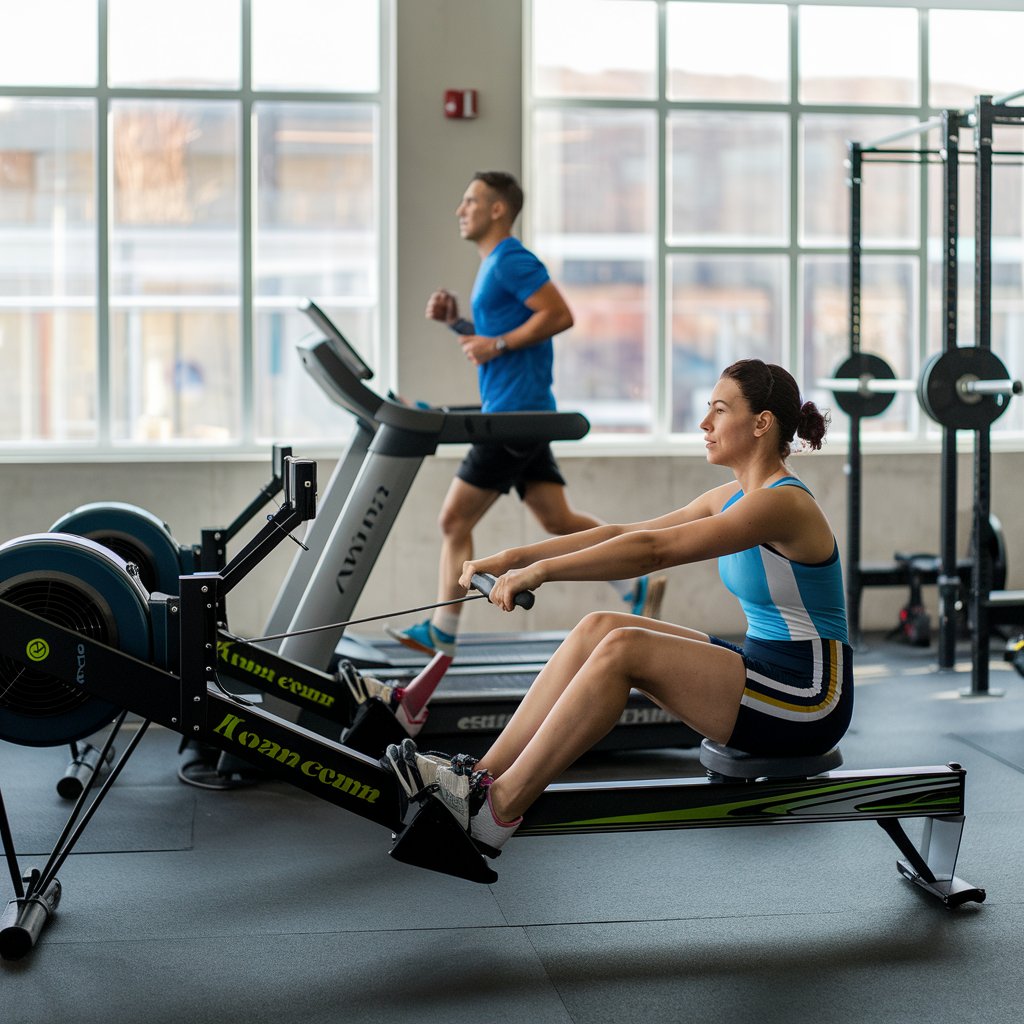
- Manual Treadmills: The user’s movement powers these treadmills. You walk or run on the belt, and your motion powers the treadmill. They are usually simpler in design and more affordable compared to motorized treadmills. Great for those on a budget or who prefer a basic workout experience.
- Motorized Treadmills: They have an electric motor. It moves the belt. You control the speed and incline. You do so through buttons or settings on the treadmill’s console. They offer more features and flexibility compared to manual treadmills. Motorized treadmills are suitable for various fitness levels and goals.
- Folding Treadmills: For people with limited room, folding treadmills are great. They can be folded up for storage when not in use. They’re convenient for home gyms or apartments where space is a concern. Just unfold it when you’re ready to work out.
- Non-Folding Treadmills: These treadmills are sturdy and often found in commercial gyms. They don’t fold up for storage, so they require more space. However, they tend to last longer than folding treadmills. They are also more stable. They can therefore be used extensively.
- Compact Treadmills: Similar to folding treadmills, compact treadmills are designed for small spaces. They are light. They usually have a smaller running surface than standard treadmills. Small treadmills are perfect for apartments or tiny home gyms. They have little space.
- Incline Treadmills: You can adjust the incline of their running surface. Walking or running uphill can make your workout harder. It targets different muscles. Incline treadmills simulate outdoor terrain and provide a challenging workout experience.
- Flat-Belt Treadmills: Standard treadmills typically have a flat belt surface. They’re suitable for walking, jogging, or running at various speeds. Flat-belt treadmills offer a smooth and consistent surface for your workout.
- Cushioned Treadmills: Cushioned Treadmills have a cushioned running surface. It reduces the impact on your joints. The cushioning absorbs some shock. This makes your workout more comfy and lowers the risk of injury. Cushioned treadmills are good for those with joint problems. They are also for anyone looking for a more comfortable running experience.
- Hybrid Treadmills: These fitness equipment blend the advantages of an elliptical with a treadmill. They offer a low-impact workout option. They have a larger, elliptical-like footpath, allowing for a more natural stride. Hybrid treadmills are great for users. They want to reduce strain on their joints while still getting a good workout.
- Curved Treadmills: Traditional treadmills have a motorized belt. In contrast, curved treadmills have a curved running surface. You power the belt with your stride, making it a more challenging and engaging workout. Curved treadmills are popular for high-intensity interval training (HIIT) and sprint workouts.
These are just a few examples of the diverse range of treadmills available on the market. When choosing a treadmill, consider your budget, space, goals, and preferences. Use these to find the best option for you.
Comparison
Cardiovascular Benefits Comparison
- Rowing and treadmill both have great heart benefits. They help to strengthen the heart and improve circulation.
- Rowing gives a full-body workout. It engages the muscles in the upper and lower bodies simultaneously. This can lead to an efficient cardio workout.
- Treadmill workouts focus on lower-body cardio. Some models offer incline options to engage more muscles.
Muscle Engagement Comparison
- Rowing uses many muscles, including the legs, core, back, and arms. It gives a full workout.
- The treadmill targets leg muscles. These include the quadriceps, hamstrings, and calves. It engages the upper body less.
Impact on Joints and Injury Risk
- Rowing is usually low-impact. The motion is smooth and controlled and puts little stress on joints.
- Treadmill running can be harder on the body. This is especially true at high speeds or with poor form. It can raise the risk of joint injuries like shin splints or knee pain.
Caloric Expenditure Comparison
- Both rowing and treadmill workouts can burn lots of calories. The time and intensity determine how much.
- Rowing has been shown to burn calories at a high rate due to the full-body engagement.
- Running on a treadmill can also burn many calories. This is true, especially during high-intensity interval training (HIIT) or incline workouts.
Accessibility and Space Requirements
- Rowing machines can be bulky and may require more space compared to a treadmill.
- Treadmills come in various sizes. They can be folded for easier storage. This makes them better for smaller spaces.
- Most gyms have both machines. But, rowing machines may be rarer in some gyms.
Suitability for Different Fitness Goals
- Rowing is excellent for overall fitness, muscle toning, and cardiovascular health. It’s particularly beneficial for those seeking a full-body workout.
- Treadmill workouts are great for improving running endurance, cardiovascular health, and burning calories. They are great for people training for races. They are also for people looking to boost running performance.
Conclusion
when comparing rowing and treadmill exercises, you must consider many key points. Both activities offer great cardio workouts. They engage many muscle groups and improve fitness. Rowing works the upper body. The treadmill focuses on the lower body. But, both can give a full-body workout with the right technique.
Also, personal preferences are key. They play a big role in choosing between rowing and treadmill exercises. Some people may enjoy the rhythmic motion of rowing. Others prefer the simplicity of walking or running on a treadmill. You must pick an enjoyable and sustainable activity. This is essential for staying motivated and sticking to your fitness routine.
Also, consider your fitness goals. They matter when choosing rowing or treadmill workouts. For those aiming to build upper body strength and improve posture, rowing may be better. People who want to improve endurance or burn calories might prefer treadmill workouts. This is unlike people who want to build strength, who would prefer weightlifting. Knowing your goals can guide your decision. It ensures that you’re doing exercises that match your goals.
In the end, the key is doing regular cardio. It doesn’t matter if you choose rowing, the treadmill, or any other activity. It is needed to get the health benefits of aerobic workouts. These benefits include better heart health, more stamina, and a better mood. Whether you’re rowing or pounding on the treadmill. Committing to regular exercise will greatly boost your well-being and quality of life. So, pick the one that suits you best and get moving!

